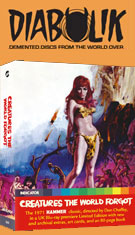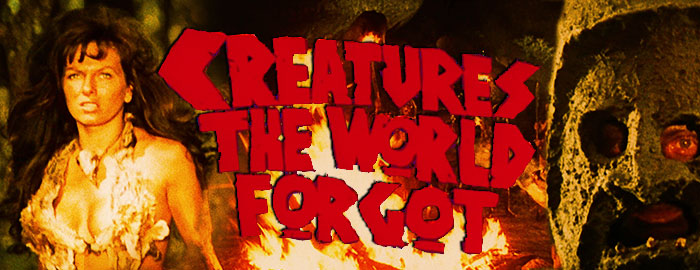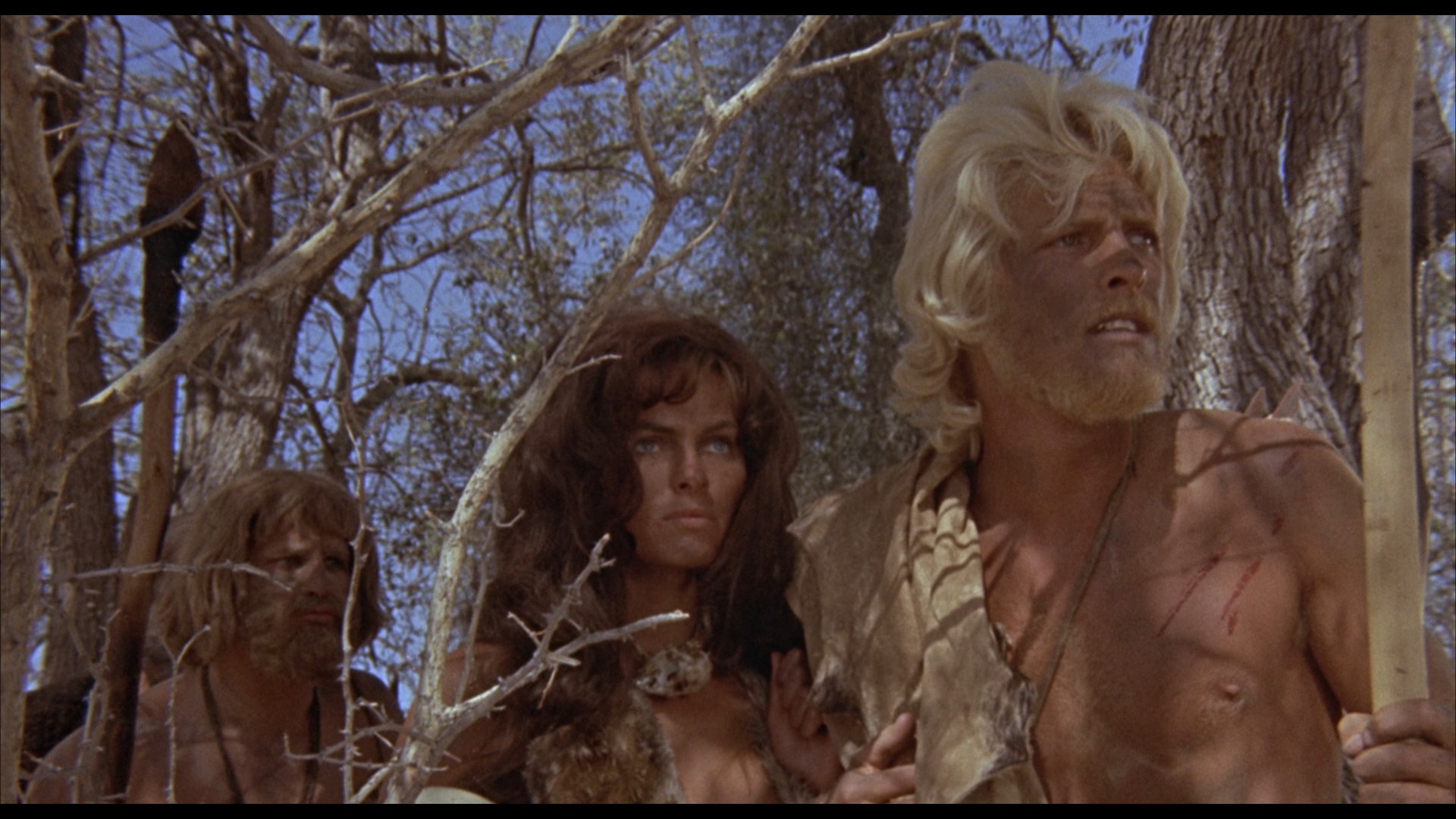

 1960s, One Million Years B.C. provided an easy,
1960s, One Million Years B.C. provided an easy,  can't-miss (and scientifically ridiculous) formula to pack in viewers in 1966: bronzed cavemen in wigs, dinosaurs, and beautiful actresses in primitive bikinis. The trend continued with films like 1967's Prehistoric Women and 1970's When Dinosaurs Rules the Earth, while Italy came up with multiple comedy spoofs on the idea like When Women Lost Their Tails. By the time the South Africa-shot Creatures the World Forgot rolled around in 1971 without a dinosaur in sight, the fad had largely faded away and the film was largely dismissed as one of Hammer's weaker efforts. Of course, virtually all of Hammer's '70s output was derided as being of lesser quality at the time and for many years to come, a consensus that has thankfully turned around in more recent years. Bear in mind that this came out the same year as Dr. Jekyll and Sister Hyde, Blood from the Mummy's Tomb, Hands of the Ripper, and Twins of Evil; not bad company! However recycled this film may have been in terms of its bewigged, spear-carrying actors, it still boasted a fine Mario Nascimbene score, some decent action direction by One Million Years B.C.'s Don Chaffey, and some often hallucinatory cinematography by Vincent Cox that foreshadows the look of sword and sorcery films in the following decade. This was also the most difficult of the Hammer prehistoric quartet to see for a long time with its scarce TV airings (due to its difficult-to-censor topless nudity and grue) and very brief VHS releases, but recently it's joined the other Hammer-Columbia staples in a number of disc editions.
can't-miss (and scientifically ridiculous) formula to pack in viewers in 1966: bronzed cavemen in wigs, dinosaurs, and beautiful actresses in primitive bikinis. The trend continued with films like 1967's Prehistoric Women and 1970's When Dinosaurs Rules the Earth, while Italy came up with multiple comedy spoofs on the idea like When Women Lost Their Tails. By the time the South Africa-shot Creatures the World Forgot rolled around in 1971 without a dinosaur in sight, the fad had largely faded away and the film was largely dismissed as one of Hammer's weaker efforts. Of course, virtually all of Hammer's '70s output was derided as being of lesser quality at the time and for many years to come, a consensus that has thankfully turned around in more recent years. Bear in mind that this came out the same year as Dr. Jekyll and Sister Hyde, Blood from the Mummy's Tomb, Hands of the Ripper, and Twins of Evil; not bad company! However recycled this film may have been in terms of its bewigged, spear-carrying actors, it still boasted a fine Mario Nascimbene score, some decent action direction by One Million Years B.C.'s Don Chaffey, and some often hallucinatory cinematography by Vincent Cox that foreshadows the look of sword and sorcery films in the following decade. This was also the most difficult of the Hammer prehistoric quartet to see for a long time with its scarce TV airings (due to its difficult-to-censor topless nudity and grue) and very brief VHS releases, but recently it's joined the other Hammer-Columbia staples in a number of disc editions.  twins who grow up to become Toomak (Bonner) and Rool (John). The pair become involved in another battle for control as tribe chief with the
twins who grow up to become Toomak (Bonner) and Rool (John). The pair become involved in another battle for control as tribe chief with the  beautiful Nala (Ege) caught in the middle of the feud, with witchcraft and duels soon thrown into the mix.
beautiful Nala (Ege) caught in the middle of the feud, with witchcraft and duels soon thrown into the mix. A new audio commentary by the spirited team of Kim Newman and Sean Hogan acknowledges that this isn't a title Hammer scholars were banging down the door to do, but they have a good time pointing out its merits and noting parallels to other films like the more
A new audio commentary by the spirited team of Kim Newman and Sean Hogan acknowledges that this isn't a title Hammer scholars were banging down the door to do, but they have a good time pointing out its merits and noting parallels to other films like the more  recent The Northman. In "Signs of Change" (25m3s), Jonathan Rigby assesses this film as a significant transitional point in Hammer's history representing their attempts to pivot for a new early '70s audience, while "Hammer's Women: Julie Ege" (6m51s) features Rachel Knightley expertly surveying the star's substantial career on the British screen as well as her life including her multiple struggles with breast cancer. In "Primitive Rites" (26m6s), David Huckvale provides another incisive analysis of Hammer music, this time noting the Nascimbene score's status as a precursor of sorts to Quest for Fire, an homage to Stravinsky, and an experimental achievement in its own right evoking a natural history feeling in tandem with the photography. Chaffey is represented with three of his early projects for the Children's Film Foundation, and anyone who's seen the marvelous BFI collections out already should have an idea of what to expect here with bite-sized capers in the bike-crazy Skid Kids (1953, 48m39s), the blue collar eatery farce A Good Pull-up (1953, 17m31s), and the most interesting of the bunch, Watch Out (1953, 17m56s), which follows the slapstick escapades of handyman Dickie Duffle as he accidentally has misadventures on the "Multi-Dimension Film Corporation" studio sets following an encounter outside with a rude honcho. All three films come with packed commentaries by Vic Pratt who goes into great detail about Chaffey, his time with the CFF, and the participants involved as well as the methods in which these were screened. Also included are the theatrical trailer, a TV spot, a radio spot, and image galleries for promotional material (106 images) and publicity photos (70 images). As usual the limited (6,000-unit) edition comes with a hefty insert booklet, this time featuring a new "Creature Feature" essay by Julian Upton about the film's place in the Hammer prehistoric cycle, cast notes from the press kit, press coverage about Ege, a publicity overview of Chaffey, promotional ideas from the press kit, bios of producer Michael Carreras and Hammer's Roy Skeggs, sample critical reactions, and a Jeff Billington essay about Chaffey's CFF work.
recent The Northman. In "Signs of Change" (25m3s), Jonathan Rigby assesses this film as a significant transitional point in Hammer's history representing their attempts to pivot for a new early '70s audience, while "Hammer's Women: Julie Ege" (6m51s) features Rachel Knightley expertly surveying the star's substantial career on the British screen as well as her life including her multiple struggles with breast cancer. In "Primitive Rites" (26m6s), David Huckvale provides another incisive analysis of Hammer music, this time noting the Nascimbene score's status as a precursor of sorts to Quest for Fire, an homage to Stravinsky, and an experimental achievement in its own right evoking a natural history feeling in tandem with the photography. Chaffey is represented with three of his early projects for the Children's Film Foundation, and anyone who's seen the marvelous BFI collections out already should have an idea of what to expect here with bite-sized capers in the bike-crazy Skid Kids (1953, 48m39s), the blue collar eatery farce A Good Pull-up (1953, 17m31s), and the most interesting of the bunch, Watch Out (1953, 17m56s), which follows the slapstick escapades of handyman Dickie Duffle as he accidentally has misadventures on the "Multi-Dimension Film Corporation" studio sets following an encounter outside with a rude honcho. All three films come with packed commentaries by Vic Pratt who goes into great detail about Chaffey, his time with the CFF, and the participants involved as well as the methods in which these were screened. Also included are the theatrical trailer, a TV spot, a radio spot, and image galleries for promotional material (106 images) and publicity photos (70 images). As usual the limited (6,000-unit) edition comes with a hefty insert booklet, this time featuring a new "Creature Feature" essay by Julian Upton about the film's place in the Hammer prehistoric cycle, cast notes from the press kit, press coverage about Ege, a publicity overview of Chaffey, promotional ideas from the press kit, bios of producer Michael Carreras and Hammer's Roy Skeggs, sample critical reactions, and a Jeff Billington essay about Chaffey's CFF work. Indicator (Blu-ray)
Mill Creek (Blu-ray)
![]()